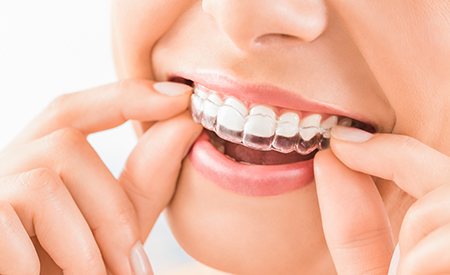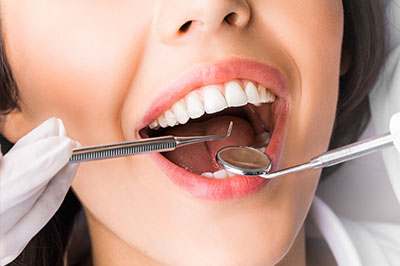We provide a variety of comprehensive services to fit your needs. See a complete list of our services and additional information below.
Dental Implants
Replacing Missing Teeth With Dental Implants
If you're missing teeth, you're not alone. Tooth loss is a far more common problem than you think. In fact, studies
show that 178 million people across the United States are missing at least one tooth, and 35 million are completely
edentulous (missing all their teeth). Whether you have lost one tooth or multiple ones to gum disease, tooth decay,
or a traumatic injury, the office of Lutz Dental can help. We provide state-of-the-art care and offer the
latest solutions to help patients reestablish complete, healthy, and beautiful smiles.
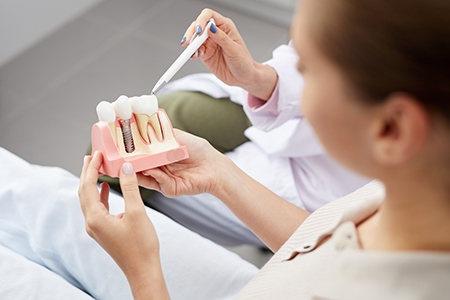
Dental implants for a smile that looks and feels completely natural!
Today, dental implants represent the most advanced system for the replacement of missing teeth. While conventional
fixed bridges and dentures remain effective and satisfying ways to replace
missing teeth, dental implants come the closest to replicating the look, feel, and function of a natural smile.
With dental implants, you can once again enjoy all your favorite foods and speak and smile with renewed confidence
and ease. Because dental implants behave in much the same way as the roots of natural teeth, they provide unrivaled
stability for the placement of a broad range of dental prostheses, including
crowns and bridges up to a complete set of
teeth. For patients who wear full dentures, dental implants provide the added stability and
retention required to improve comfort and fit while preventing any embarrassing slippage.
If you are struggling with tooth loss and looking for the best solutions for the replacement of missing teeth, visit
the office of Lutz Dental to learn more about dental implants and all the state-of-the-art services we
provide. At the office of Lutz Dental, we take pride in creating beautiful and healthy smiles!
Dental implant basics
Dental implants are small, biocompatible surgical posts that behave in much the same way as the roots of natural teeth. Once placed and integrated with the surrounding bone, dental implants provide unparalleled support for single crowns, bridges, and dentures. As the most advanced method for the replacement of missing teeth, they offer satisfying, long-lasting, and functional solutions for rebuilding a complete smile.
Consider all the benefits
Whether you’re missing one tooth, multiple ones, or missing all your teeth, you can rebuild a complete and beautiful smile with dental implants! According to statistics, roughly 3 million people have already received dental implants, with that number increasing at a staggering rate of 500,000 per year! The soaring popularity of dental implants is attributed, in large part, to the numerous benefits they offer as compared with other methods of care.
While conventional fixed bridges and dentures provide effective and satisfying solutions for the replacement of missing teeth, dental implants offer several advantages over traditional methods of care:
- Dental implants come the closest to replicating the look, feel, and function of natural teeth.
- With precise placement, good oral hygiene, and routine care, dental implants can last for many years.
- Dental implants provide continued stimulation to the underlying bone to prevent the bone loss that occurs when teeth are missing while preserving natural facial contours.
- Since implants behave like natural teeth, there is no chance that they will slip or dislodge like removable dentures when speaking or eating.
- Dental implants make it possible to speak with ease and eat and taste all types of food with virtually no restrictions.
- Dental implants do not decay and will not develop cavities.
- Unlike a fixed bridge, dental implants do not require any preparation or crowning of teeth adjacent to the edentulous area.

The Most Versatile Solution for The Replacement Of Missing Teeth
Types of Dental Implants:
Single-tooth implant
When a single tooth is missing, a dental implant restored with a crown replicates a natural tooth in almost every way. It’s no longer necessary to fabricate a conventional three-unit bridge involving the preparation and crowning of any adjacent teeth. As a self-supporting and fully functional entity, a single tooth implant offers patients an excellent solution for reestablishing a complete and attractive smile.Implant-supported fixed bridges
As used to replace two or more missing teeth, an implant-supported bridge preserves the integrity of the adjacent natural teeth while providing the ongoing bone stimulation needed to prevent bone shrinkage and maintain facial contours. Unlike a traditional fixed bridge to replace multiple missing teeth, an implant-supported bridge does not require the preparation and crowning of any adjacent natural teeth. Instead, it relies on a select amount of strategically placed dental implants to support all the crowns and replacement teeth needed.Full arch replacement with four or six Implants
Serving as an alternative to full dentures, a complete set of replacement teeth supported by strategically placed implants successfully reestablishes a smile that looks, feels, and functions like a natural one. Unlike conventional dentures, this approach offers a fixed solution that’s both stable and non-removable. While eliminating the need for messy denture adhesives and having to take any dentures out to clean and sanitize them, it boosts confidence as one speaks, smiles, and chews. It also permits the immediate placement of an attractive set of temporary teeth, with a permanent set to follow once the implants become fully integrated with the surrounding bone.Implant-retained denture
As the name implies, this type of denture attaches to a select number of strategically placed implants in the upper or lower jaw. These small surgical posts provide precise points of attachment for the overlying denture and add a significant measure of stability and retention. This added level of security enables one to smile, speak, and eat with greater confidence and ease.
Are dental implants right for me?
If you are wondering if you’re a candidate for dental implants, it’s easy enough to find out. At the office of Lutz Dental, we’re not only happy to look at your smile, but we’ll also answer all your questions and explain your best options for dental implants. We treat every smile as unique and develop personalized treatment plans based on your medical and dental histories, current oral health, cosmetic expectations of care, lifestyle, and budget.
How are dental implants placed?
It’s essential to plan and meticulously execute every step in care, from initial treatment planning and the precise placement of dental implants all the way to the design, fabrication, and insertion of the final crowns, bridges, or dentures.
Surgery to place dental implants is typically considered a minor surgical procedure and performed on an outpatient basis. However, the exact extent of the procedure depends upon the type and number of dental implants and whether or not any additional procedures are required to prepare the supporting bone.
We view communication as a vital part of patient care. Before your dental implant procedure, we’ll discuss dental anesthesia, options for dental sedation, and provide detailed pre-op and post-op care instructions. You can count on our office to keep you well-informed every step of the way.
Once a dental implant gets placed, it takes a few months to integrate fully with the surrounding bone. While a few implant solutions allow placing a same-day temporary crown or bridge, others require waiting for complete healing and osseointegration (fusion with the surrounding bone) to place the permanent prostheses.

Why might I need a bone graft to get a dental implant?
According to clinical studies, dental implants have a demonstrated long-term success rate of well over 95%. However, the long-term stability and success of a dental implant depend upon the presence of sufficient bone at the time of placement. In cases of periodontal disease or following the extraction of a tooth, bone volume is often lost. By placing a bone graft in the extraction site, or prior to the placement of a dental implant, we can establish sufficient bone support for a sturdy and stable dental implant.
Let The Office Of Lutz Dental Help You Rebuild A Beautiful Smile
Missing teeth do more than cause embarrassing gaps in your smile. For one thing, they can also affect your ability to speak or chew nutritious food with ease. By not replacing missing teeth, the adjacent ones can shift towards the space over time and change your bite and compromise the health of your smile in many ways.
With all of the advances in dental materials, technology, and treatment methods available today, it’s easier than ever before to replace missing teeth with the most natural-looking and aesthetically pleasing results of care.
At the office of Lutz Dental, we’re pleased to offer leading solutions to improve your oral health and give you a smile you can feel confident sharing with the world. We give you back the complete smile you have lost and provide personalized solutions for all of your oral healthcare needs. To find out more about dental implants or schedule an appointment so that we can take a closer look at your smile, give us a call today.
Emergency Dental Care
Emergency Dental Care

Dental emergencies can come about in any number of ways. Your discomfort may be due to an injury to the oral facial area, the acute flare up of a longstanding problem, or the result of the sudden onset of seemingly inexplicable pain. Whatever the case may be, urgent dental care is needed to provide you with relief and to avoid any further consequences to your oral health or function, as well as your overall well being.
There are many reasons to seek emergency dental care, including severe toothaches, chipped or fractured teeth, a dental abscess, impacted teeth, loose or broken fillings, lost or dislodged crowns, broken dentures and more. While the pain of a toothache is one of the more common reasons that patients come to our dental office for emergency dental care, we also promptly treat emergencies that are not necessarily painful like crowns that have been dislodged and broken dentures that leave embarrassing gaps in one’s smile.
Whether your dental emergency is painful, if it affects the appearance of your smile, or if you suspect that an infection is present, contact our office immediately for care. We will make every effort to see you as promptly as possible.

Toothaches
A toothache is the most common reason for oral pain. It is an uncomfortable, distressing and debilitating situation that if left untreated can result in serious consequences to an individual’s oral health as well as overall well-being. Depending upon the underlying cause of a toothache and the degree of damage to the tooth and involvement of the surrounding tissues, the type and severity of symptoms can vary. While mild symptoms of discomfort are easy to dismiss and ignore, waiting until toothache pain is more consistent or severe is not advised. The best option is to make a timely appointment with the dentist for a professional assessment and care.
Although the reason for most toothaches is cavities (tooth decay/dental caries), a toothache or what may feel like pain related to the teeth can be due to any number of underlying conditions including:
- A Cavity
- Dentin Hypersensitivity (Sensitive teeth)
- Dental Trauma resulting in chips, fractures, cracks or nerve damage to the tooth
- Infection or Abscess
- Periodontal Disease (Gum Disease)
- Bruxism
- Erupting or Impacted Teeth (wisdom teeth are often problematic)
- Sinus or Ear Infections
- Other medical conditions with referred pain to the jaw
Different types and degrees of toothache pain can point to different underlying causes and help in the diagnosis of the problem. Sharp and stabbing pain when eating or drinking hot and cold foods may be due to the presence of a cavity or exposed dentin and sensitive teeth. Pain with pressure or biting down may indicate a cavity or even a broken filling, a cracked tooth or periodontal problem. If the pain is continuous or throbbing, it is a sign that tooth decay or trauma has affected the nerve of a tooth or that an infection requiring prompt care is present. Localized swelling around the tooth or more generalized tissue and facial swelling and fever must be taken care of as quickly as possible.
Treatment of a toothache depends upon the diagnosis of the underlying problem, the degree of damage to the involved tooth or surrounding tissues and if any infection is present. Once the dentist has performed a comprehensive evaluation of the case, the appropriate recommendations and care to alleviate the symptoms and restore oral health will be provided.
Traumatic Injuries
Traumatic oral injuries can range from dental injuries to the teeth and their supporting tissues to lacerations in and around the mouth as well as more complex and severe damage to the soft tissues and bones of the face. These injuries are often caused by direct physical trauma to the teeth, mouth and face that may be the result of a fall, sports or work related incidents, motor vehicle accidents or assaults.
Chipped, Fractured or Cracked Teeth
It is not uncommon for a tooth to sustain a chip, crack or fracture. It may happen simply from biting down on a piece of ice, chewing on a pencil, or sustaining trauma such as a direct blow to the face and mouth. The damage to a tooth can range from a minor craze line or a small chip of the dental enamel to a more extensive fracture of the tooth that can even go so far as to fracture the root or split the tooth. Based upon the extent of damage to the fractured or cracked tooth, treatment may simply involve placing a suitable restoration such as a filling or crown or a root canal procedure along with a restoration. When the damage is extensive, an extraction is sometimes required.
Dentoalveolar Injury
Dentoalveolar injuries refer to traumatic injuries involving the teeth and the bone surrounding the teeth. These injuries can include teeth that have been dislodged or moved partially out of their sockets, with or without a segment of the adjacent bone, or an avulsion, which means that a tooth has been completely “knocked out” of its socket. In these situations, immediate dental care to reposition and stabilize the involved teeth and/or put the bone back into the correct anatomical positions is required. Beyond the routine post op care to check for tissue healing, the involved teeth are typically followed for a longer period of time to check for subsequent nerve involvement or other issues that may require additional care.
Soft Tissue Injuries
Soft tissue injuries in and around the oral cavity include lacerations within the mouth (intra-oral) and facial lacerations. If possible clean the area gently with water and apply a cold compress. For puncture wounds, tissue tears, and lacerations to the lips, cheeks, tongue or any other tissues in and around the oral cavity, prompt emergency care is required.
Dislocated or Fractured Jaw
Facial trauma that has resulted in a suspected dislocation or jaw fracture requires immediate care as problems with eating and breathing can ensue. Prompt care can minimize complications and accelerate healing. For a fractured jaw, treatment depends upon the extent of the injuries. While some clean breaks may only require immobilization, multiple fractures of the jawbone or displaced breaks involve more complex surgical care. If on the other hand the jaw has been dislocated as a result of a traumatic incident or opening the mouth too widely, it will need to be manipulated back into the correct position. For people who have had more than one dislocation, surgery may be needed to reduce the risk of further dislocations.
Tooth Removal
Cosmetic Dentistry
Cosmetic Dentistry
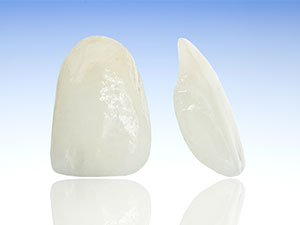
Once commonly referred to as, "porcelain jackets," today's all-ceramic crowns are fabricated from advanced generations of aesthetically appealing, lifelike materials affording strength and durability approaching that of tradition metal and porcelain fused to metal crowns (PFM).
When a tooth requires a full coverage restoration to rebuild its structural integrity and appearance, how good the crown will look and how well it will withstand the forces of oral function are major considerations in choosing the type of crown. In the past, only metal crowns or ones fabricated out of porcelain fused to an underlying substructure of metal offered the strength required to bite and chew without breaking. While porcelain fused to metal crowns to this day remain a popular choice for strong, attractive and long-lasting restorations to rebuild teeth that are damaged, decayed, misshapen, worn down, undersized, or have had a root canal procedure, there are some drawbacks. For one thing, the thin metal margin at the collar of a PFM crown may be visible at the gumline (especially in the presence of receding gums). Also, due to the presence of an underlying metal shell, porcelain fused to metal crowns do not come close to handling light in the same way as natural tooth structure or dental ceramics.
Advantages of Ceramic Crowns

While the trade off between appearance and strength used to mean that porcelain or all-ceramic crowns looked better but did not have the strength and durability of porcelain fused to metal crowns that is no longer the case. All-ceramic crowns are not only capable of producing incredibly lifelike results, but thanks to the range of materials available today, all-ceramic crowns are stronger and more reliable than ever before.
Some of the advantages of all-ceramic crowns include:
- All-ceramic crowns interact with light in much the same way as natural teeth and can closely mimic their translucency and luster
- All-ceramic crowns can be made thinner and require less tooth reduction
- All-ceramic crowns are kinder to the surrounding tissues, for potentially healthier long-term results
- All-ceramic crowns are resistant to stain and discoloration
- All-ceramic crowns are metal-free and safer for individuals with allergies or sensitivities to metal
With the range of engineered dental ceramics available today, which material is selected for crown fabrication depends upon the location of the tooth, the stresses on that tooth and the esthetic requirements of the case. Certain all-ceramic crowns are more suited for back teeth, while others are able to fulfill the aesthetic requirements presented by a front tooth.
Dental Bridges
Dental Bridges
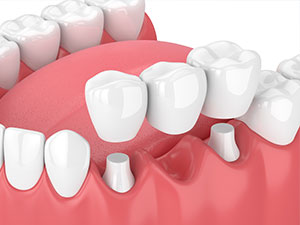
When teeth are missing, a series of changes that can impact your overall dental health and jaw function may begin to develop. The adjacent teeth may start to drift or tilt into the space, and teeth in the opposing jaw may start to shift toward the area of the missing tooth. It is therefore important to replace either the single tooth or multiple teeth that are missing from this area. One of the best options to prevent the consequences of shifting teeth and to restore full function to a small edentulous section in the mouth is a dental bridge.
A dental bridge replaces the missing teeth with artificial teeth called "pontics," and is supported on the ends by prepared natural teeth. Once fabricated and fitted a dental bridge will be permanently "fixed," or cemented into place. Like crowns, bridges can be made of either porcelain baked on to a metal substrate or many of the new ceramic materials that have been developed.
Fixed Bridges

Fixed dental bridges involve the preparation and crowning of teeth on either side of an area missing teeth to support artificial teeth to span the edentulous area.
A fixed bridge is a non-removable appliance fabricated to replace missing teeth, which closely resembles a patient's natural dentition. Besides serving to restore the appearance and performance of a complete smile, a fixed bridge also prevents teeth that are adjacent to or opposite the edentulous area from shifting to protect the integrity of the occlusion. Fixed bridges are strong, durable and natural looking restorations, which once they are permanently cemented into place allow all manner of normal oral function.
How are fixed bridges fabricated?
Fixed bridges are typically fabricated over the course of multiple visits and involve the preparation of the adjacent supporting teeth, impression taking, the placement of a temporary bridge as well as the try-in and cementation of the permanent restoration. The teeth located on either side of the edentulous area that are crowned to provide support for the bridge are referred to as the "abutment teeth," while the artificial tooth (or teeth) spanning across the empty space are known as "pontics."
With the dental technology available today, bridges can also be completely supported by implants without any preparation or crowning of the adjacent natural teeth required. Depending upon the aesthetic and functional needs of a case, fixed bridges can be fabricated from different dental materials including porcelain, porcelain fused to metal, or engineered ceramic-like products such as zirconia.
Full Arch Implant Supported Fixed Bridge
As an alternative to full dentures, a full arch fixed bridge anchored to multiple dental implants can offer a permanent solution in situations where all the teeth are missing or have been deemed non-restorable and need to be replaced. A full arch fixed bridge anchored to dental implants is a highly stable and cosmetically pleasing solution that lets you eat and function as you would with a full set of natural teeth.
Periodontal Disease Prevention & Treatment
Periodontal Disease Prevention & Treatment
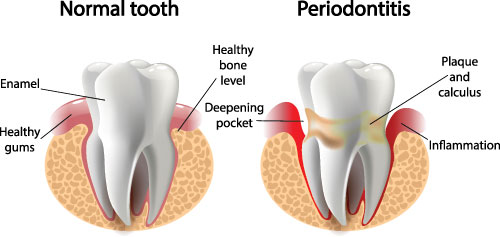
Non-Surgical Periodontal Treatment
When periodontal disease is detected early in its onset, conservative or non-surgical methods of care in combination with improved hygiene routines can restore periodontal health. While periodic, professional cleanings are sufficient to maintain periodontal health in patients that do not have gum disease, once gingivitis is present, deeper cleanings and possibly other non-surgical methods of care are recommended to treat the condition.
The American Academy of Periodontology emphasizes achieving periodontal health by means of the least invasive and cost effective treatment approaches to care. Deeper cleanings, which include Scaling and Root planing, are non-surgical procedures that are considered the first line of defense against the progression of periodontal disease.
With scaling and root planing, any plaque and tartar (hardened dental plaque) that have accumulated below the gumline are carefully removed and then the root surfaces of the teeth are smoothed. Since, periodontal disease is an inflammatory response to plaque, tartar and bacterial toxins, by simply mechanically eliminating these agents, the progression of gum disease can be halted. In addition to removing plaque and tartar with a scaling and root planing procedure, antimicrobial medication placed under the gumline or systemic medications can be used as adjuncts to care to further reduce the bacterial population.
If non-surgical approaches to managing periodontal disease do not achieve the desired outcome, surgery may be recommended to halt its progression and repair damage as possible.
Periodontal Surgery

When gum disease has advanced beyond the initial stage, periodontal surgery is often recommended to effectively remove bacteria and tartar from around the teeth, reduce gingival pocket depth, restore lost tissue as possible and halt the disease process. Untreated gum disease is a progressive condition, which will continue to compromise the appearance of one's smile, dental health, oral function and overall well being if the appropriate measures are not taken.
With proper surgical treatment and maintenance care, the chances of tooth loss, further damage to the bone and soft tissues supporting the teeth, and complications from health problems that are linked to periodontal disease can be decreased.
Gum disease is typically the result of inadequate or ineffective oral hygiene practices that lead to the accumulation of dental plaque, which is sticky film that is colonized by oral bacteria. The harmful bacteria and the products they produce provoke a defensive, inflammatory response in the gums. When this inflammation is not resolved, tissue damage ensues and spaces between the gums and teeth that are known as periodontal pockets develop. As the periodontal pockets deepen, the bacteria become more difficult to remove and the gaps between the surface of the teeth and gums get larger. When pocket depth increases to the point of being beyond the reach of deep cleanings and other conservative methods of care (5mm or more), gum surgery to clean and treat the damage to gums and underlying bone is recommended.
By performing pocket reduction surgery the following is accomplished:
- Sub-gingival bacteria beneath the gums and from the surfaces of the roots of the teeth is removed
- Damage to the underlying bone is halted and affected bone is re-contoured
- Effective oral hygiene to clean the teeth and gums is made easier
While a surgical procedure known as flap surgery during which the tissue is surgically reflected away from the teeth and bone so that the area can be treated before the tissue is sutured back into place, is typically performed, some practitioners are now using soft tissue laser procedures to reduce pocket depth.
Crown Lengthening
Crown lengthening is a common procedure that is routinely performed to re-contour gum tissue and bone, as needed, with the intent of making more tooth structure available for the placement of a dental crown or dental bridge. This is often the case when a tooth is decayed or otherwise damaged below the gum line.
Alternatively, a crown lengthening procedure can also be performed for reasons that are purely aesthetic to reduce the appearance of a "gummy smile" when too much of the gums and far too little tooth structure is displayed when smiling. It can be performed on a single tooth to make the gum line appear even with the other teeth or on several teeth to improve a smile's overall appearance.
Soft Tissue Grafts or "Gum Grafts"
In addition to the development of pockets and bone loss, periodontal disease can cause the gums to recede, thereby exposing the roots of the teeth. When the root of a tooth loses its overlying soft tissue, it becomes more vulnerable to decay, sensitivity and additional bone loss. Gum recession also takes a toll on smile aesthetics. Having front teeth affected by this problem can make a broad smile less aesthetically appealing as uncovered root structure is displayed. While gum recession is often a consequence of gum disease, aggressive tooth brushing and other habits can also wear away gum tissue.
By performing a gum graft procedure, which is also known as a "gingival graft or soft tissue graft," the dentist replaces the soft tissue over the exposed area of the tooth to address the problems created by receding gums. Gum tissue for grafting procedures can be harvested from a nearby site in the mouth or obtained from another donor source. A gum graft may be performed on a single tooth or multiple ones. And, based upon the needs of the case, the dentist will determine which type of gum graft to employ.
The three types of gum grafts include the following:
- Free gingival graft - This graft utilizes a small piece of tissue that is taken from the palate. It is often indicated when extra thick tissue is needed to prevent further recession.
- Connective tissue graft - This frequently used graft is harvested from a sub-layer of connective tissue located under the uppermost tissue layer on the roof of the mouth.
- Pedicle graft - This type of graft is created from a flap of tissue that is adjacent to the area of the gum recession.
Following a gum graft procedure, the dentist will provide detailed post-operative care instructions as well as set up appointments to make sure the surgical site is healing properly and to check that the graft is successful.
Osseous Grafts or "Bone Grafts"
Bone loss in the jaws and around the teeth can be the result of missing teeth, periodontal disease, or trauma. This bone loss is more than a detriment to oral health and function; it can also alter facial appearance as the support for the natural contours of the face is diminished.
When a tooth is extracted, the natural stimulation to the underlying bone that is generated by the forces of biting or chewing is lost. In fact, bone width can be reduced by as much as 25% in the first year following tooth loss.
With grafting procedures, the dental bone can be restored to its original dimensions to maintain facial esthetics, repair the damage caused by periodontal disease as well as facilitate the success of procedures such as the placement of dental implants. A bone graft provides a platform or "scaffolding" for new bone growth and the material for a bone graft can be derived from the patient, other donor sources or be comprised of synthetic, bone-like materials.
There are several types of grafting procedures that can be performed with the particular approach depending upon the needs of the case.
A bone graft can be placed immediately upon the extraction of a tooth or some time after tooth loss. Placing a bone graft at the time of tooth removal reduces the amount of bone loss in the area to maintain the hard tissue support that is required for the future placement of a dental implant. When a bone graft is placed awhile after tooth loss, a separate surgical procedure is required to reflect the soft tissue, expose the underlying bone, place a graft and then suture the soft tissue back into place.
For patients lacking a sufficient amount of bone for a dental implant to replace a maxillary back tooth (upper back tooth), a procedure known as a "sinus lift" may be performed. During this surgical procedure, the sinus membrane is lifted and bone graft material is added between the jaw and the floor of the sinus to provide the needed bone height to successfully support a dental implant.
In addition to bone grafting for purposes of ridge preservation or augmentation to allow for dental implants, an aesthetic ridge augmentation procedure to restore the natural contours of the bone is sometimes performed in preparation for fixed bridgework to achieve a more cosmetically pleasing result.
To guide tissue regeneration as well as protect the graft and promote healing, special membranes and biologically active materials may be placed over the grafting material.
Root Canal Therapy
Root Canal Therapy

A root canal procedure is considered one of the most effective methods of saving and retaining a tooth that has been severely compromised by dental decay or injury.
According to the most recent American Dental Association Survey of Dental Services, almost 41,000 root canals are performed every day in the U.S. and close to 15 million are done over the course of a year. Since the success rate of endodontic treatment is well over 90%, and because maintaining a patient's natural dentition is essential to overall oral health, root canal therapy as opposed to having the involved tooth extracted is a widely recommended option in care.
A root canal procedure is indicated when the vital tissues, which are referred to as the “pulp,” become inflamed or infected in response to an injury, deep dental decay or an advanced case of periodontal disease. Every tooth has either a single, central canal or multiple ones that contain the blood vessels, nerves, and connective tissue, which comprise the dental pulp. These pulp tissues are essential for a tooth to develop, mature and erupt into place. Once a tooth has emerged, the dental pulp provides nourishment to keep the tooth vital and serves to alert an individual that decay or some other type of damage is affecting the tooth. Having sensitivity to various stimuli like biting down and eating or drinking hot or cold items is a warning from the nerves inside your tooth that dental disease or trauma is taking a toll on the tooth, or infection is brewing. The degree of pain that you experience depends on the extent of the damage and nerve involvement.
When Is A Root Canal Procedure Recommended?
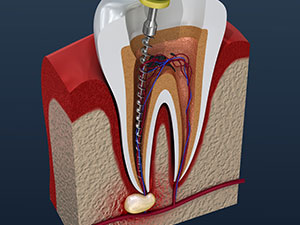
A root canal procedure is recommended when the dental pulp has become irreversibly damaged or has died, but enough healthy tooth structure and bone support remains around the tooth to save and maintain it. Since a fully developed tooth does not require the dental pulp to remain functional, a natural tooth can be effectively preserved with a root canal. During this procedure, the dentist removes the diseased dental pulp, cleans the internal portion of the tooth, and then fills all the prepared canals with a biocompatible filling material. Once the canals have been sealed and the tooth is symptom-free, the tooth will need a suitable restoration to reestablish its appearance and function and to strengthen it to withstand the forces generated in the mouth. With proper care, a tooth that has received a root canal therapy and restoration can be maintained for many years.
Modern technology and advanced methods of care make getting a root canal procedure as comfortable, and no more complex, than getting a routine dental filling. While some root canals can be completed in one visit, others may involve 2 or 3 appointments. How many visits it takes to complete a root canal procedure depends on factors such as the number of canals in a tooth, their anatomy and whether an active infection is present.
When root canal therapy is recommended, it is important to get timely care. If left untreated, the damage to a tooth and the risk of infection increase, as do the consequences to oral health and overall well being.
Dental Cleanings
Dental Cleanings
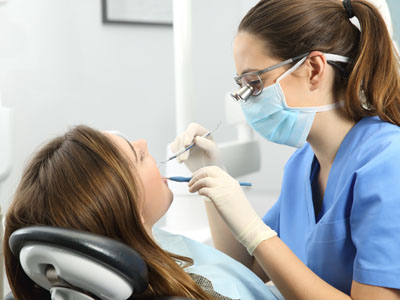
Dental Cleanings and Oral Hygiene
Although these two conditions are largely preventable, dental decay (caries) and periodontal disease, which is more commonly known as gum disease, represent the two biggest threats to your oral health. As part of an effective program of preventive care, thorough periodic cleanings at the dental office along with guidance in the best methods of brushing and flossing at home, play an essential role in warding off the development of cavities as well as the onset and progress of periodontal disease.
A routine dental cleaning as performed by the dentist or dental hygienist involves the thorough removal of any accumulated plaque and tartar from areas that your toothbrush and floss have not reached. Since dental plaque harbors the bacteria that are responsible for cavities and gum disease, its removal prevents these disease processes from occurring. Following a dental cleaning and polishing, which is performed to remove any superficial stains from your teeth, your mouth will feel fresh and clean.
Checkup and cleaning visits also represent an important opportunity to educate patients in the best oral hygiene homecare methods and routines to maintain a healthy smile. Your dental team will carefully explain and demonstrate proper techniques for brushing, flossing and other oral care practices at your initial dental appointment and subsequent recall visits.

Periodic Fluoride Treatments
According to the National Institute of Dental and Craniofacial Research, tooth decay is the single most common chronic childhood disease. Over 50 percent of 5 to 9 year old children have at least one cavity or filling, with that proportion increasing to 78 percent among 17-year-olds. Additionally, more than 51 million school hours are lost each year to dental-related illness.
As an added level of protection against dental decay, it is recommended that children receive periodic fluoride treatments as part of a program of preventive dental care. Fluoride is a naturally occurring mineral that helps to prevent cavities by making the hard outer enamel of the teeth more resistant to the acids produced by the harmful sugar processing bacteria in dental plaque. It can also help to remineralize the teeth to reverse incipient decay.
During a periodic checkup visit, the dentist may recommend the application of a topical fluoride to help strengthen and protect both a child’s baby teeth and the permanent ones. Topical fluorides can be applied as a foam, gel or varnish. Whatever type is selected, the procedure is quick and painless. Once the teeth are cleaned the fluoride is simply painted on the surfaces of the teeth or placed in a small tray to sit over the teeth for a brief period of time. Some types of fluoride treatment require no eating or drinking for half an hour as the fluoride is absorbed into the surface of the teeth. The dentist and dental hygienist will provide specific and detailed instructions as needed.
Fluoride treatment may also be indicated in adults who are at a higher risk for developing tooth decay.
Oral Exams
Oral Exams

Your first visit to our office is very important with regard to establishing your oral health baseline. We will begin by carefully reviewing your medical and dental histories and taking special note of all of your dental concerns, as well as any symptoms that you may be experiencing. This will be followed by a thorough clinical examination, including an oral cancer screening, periodontal evaluation, an analysis of your occlusion (bite) plus a thorough examination of your teeth, their supporting structures, and the complete orofacial area. Any needed diagnostic dental films will be taken at this time.
Dental Checkups

By scheduling a periodic appointment for a checkup and professional dental cleaning, your dentist can help to keep your smile looking good and functioning at its best. At every checkup visit, your medical and dental histories are carefully reviewed and a comprehensive examination of your mouth, jaws, and surrounding areas of the head and neck is performed. While checking for the development of common dental conditions such as tooth decay and gum disease and doing a screening for oral cancer, your dentist will also make note of any signs of problematic health issues that may have originated elsewhere in the body. Experiencing dry mouth, bad breath, gum problems, ulcerations or other oral lesions may be indicative of a serious underlying systemic condition. As part of a comprehensive clinical exam, the dentist will assess the function of your temporomandibular joints (TMJ) and your bite (occlusion) for any impairment or misalignment. The consequences of various dietary choices, eating disorders, harmful habits, certain medications and inadequate oral hygiene practices may also be detected at this time.
Teeth Whitening
Teeth Whitening
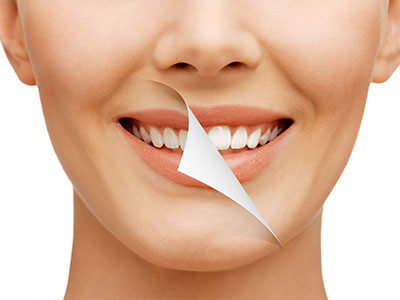
A teeth whitening procedure or bleaching simply refers to any process that will make the teeth appear whiter. It is considered a non-invasive procedure that is designed to whiten and brighten teeth that are stained, discolored, darkened, or yellowed. First introduced to the public in the 1980’s, the popularity of teeth whitening products and procedures has soared. According to a survey conducted by the American Academy of Cosmetic Dentistry, when respondents were asked, “What would you like to improve most about your smile?” The most common response was: whiter and brighter teeth.
How white a tooth appears depends upon how light is reflected and scattered off the enamel, the outermost layer of the tooth. Teeth can look dark or discolored for a variety of reasons, with an imperfect appearance the result of outer surface stains or discoloration from within the tooth. While external tooth stains are typically due to certain foods and tobacco, internal tooth discoloration is mainly the result of hereditary factors, certain medications, tooth decay, restorations, or trauma. Additionally, the aging process can influence the color of a tooth. This is because over time the outer layer of enamel becomes thinner showing more yellowish tones from the underlying layer of dentin.
What are the advantages of a professional teeth whitening procedure performed by a dentist?

Although over the counter teeth whitening systems purchased in stores or online have become popular, there are health concerns and limitations with these products. If the manufacturers protocol is not correctly followed, certain products can damage the teeth and soft tissues in the mouth, and may not deliver the results as promised. Teeth whitening systems contain varying concentration of either hydrogen peroxide or carbamide peroxide, which act as the bleaching agents. When sensitive teeth, exposed roots, cavities, broken fillings, cracked teeth, or loose dental work are present, a teeth whitening procedure may be contraindicated. Also, since whitening systems do not have an effect on the color of dental fillings, crowns or bridges the presence of restorations is an important cosmetic consideration in treatment planning.
In general, individuals with yellow tones to their teeth respond best to teeth whitening procedures. Brown and grayish tinted teeth bleach respond less well and may require significantly longer dentist supervised tooth whitening regimens or alternative cosmetic treatments. Finally, teeth whitening may not be recommended in the presence of sensitive teeth, worn enamel and significant gum disease.
As a rule the healthiest and most effective methods of teeth whitening are the ones managed and supervised by the dentist. An in-office teeth whitening procedure as performed by the dentist is the most reliable and safest way to get the maximum results quickly. In as little as one hour a prescription-strength, in-office whitening procedure can dramatically whiten and brighten the natural teeth by several shades, while the surrounding tissues and any sensitive areas of the teeth are carefully isolated and protected from the bleaching agents.
A home whitening system from the dentist along with custom trays that have been fitted to the teeth is also an excellent option. Custom trays keep the bleaching agent in maximum contact with the teeth and away from the other areas of the mouth. With a take-home teeth whitening system, maximum results are less rapid than an in office procedure and are typically achieved over a longer period of time. A home whitening system can be used by itself or as recommended by the dentist as a follow up to an in office procedure in order to perfect or maintain the results.
Dentures & Partials
Dentures & Partials

According to the National Institute of Dental and Craniofacial Research (NIDCR), 3.75% of adults 20 to 64 in the United States are completely edentulous. For the overall population in this age group, the average number of remaining teeth is 24.92 out of a total of 32 permanent teeth.
One of the ways to replace missing teeth to restore oral function and appearance is with dentures. Depending upon the needs of a case, dentures can be used to replace either a few teeth that have been lost or all of the teeth in the upper or lower jaws. In addition to reestablishing the look of a complete and natural smile, dentures also restore support to the natural contours of the face to eliminate the “sunken” appearance that results from losing multiple teeth. Whether teeth have been lost for reasons of tooth decay, gum disease, a medical condition, congenital anomaly, or trauma, dentures are an effective method of care.
Dentures are removable appliances that are designed to precisely and comfortably rest on top of the gums that cover the jawbones. They can be taken out of the mouth for brief periods of time to fulfill the oral hygiene requirements of maintaining the underlying tissues, cleaning the dentures, and sleeping.
Types of Dentures

The two main types of dentures are: full dentures and partial dentures. Both types are custom fabricated based on the exact specifications obtained from dental impressions and detailed functional as well as esthetic information provided by the dentist.
Full Dentures
Full dentures, which can also be referred to as, “complete Dentures,” are designed to replace all of the upper or lower teeth. A complete maxillary denture, more commonly known as a, full upper denture, typically consists of a base that covers the roof of the mouth with a full complement of artificial teeth set around the section covering the dental arch. On the other hand, a complete mandibular denture, or full lower denture, is designed to accommodate the tongue and is horseshoe shaped with teeth set along the portion that covers the underlying dental arch.
- Conventional Full Denture - A conventional full denture is fabricated and placed after all of the remaining teeth have been removed and the tissue is healed. It takes several weeks for extraction sites to heal and for all of the surrounding bone and gum tissues to fill in and remodel. By allowing this process to reach completion before taking the final impressions for a new denture, the most precise and comfortable fitting prosthesis can be fabricated.
- Immediate Denture - An immediate denture is one that is inserted on the day the remaining teeth are removed. With this method of care, a patient does not have to be without teeth while waiting for complete healing of the extraction sites. Immediate dentures offer the distinct cosmetic advantage of not having to be without teeth. However, since the healing of the extraction sites is occurring while wearing the denture, a reline or new denture may be required later for improved comfort and fit.
- Overdenture - An overdenture is a type of complete denture that receives added stability and support from special attachments that are secured to the remaining underlying teeth or strategically placed dental implants.
Partial Dentures
A partial denture is a type of removable prosthesis that is designed to restore a complete and functional smile in cases where multiple teeth are missing or require extractions, while some healthy teeth remain in the dental arch. Custom fabricated for a precise fit and cosmetically pleasing appearance, partial dentures are typically secured and stabilized with clasps or precision attachments to select teeth adjacent to the edentulous areas. Depending upon the number of teeth being replaced as well as the functional and aesthetic requirements of the case, a partial denture can be fabricated from a combination of cast metal and acrylic materials, acrylic alone, or thermoplastic resins such as Valplast™, Flexite®, Duroflex® and tcs®.
Tooth-Colored Fillings
Tooth-Colored Fillings

With advances in dental materials and science, restorative materials that are aesthetically pleasing as well as strong and durable are widely available for the filling and repair of teeth that have been affected by tooth decay or dental injuries.
Composite fillings, which are frequently referred to as either “tooth colored fillings” or “white fillings,” are a combination of biocompatible resins and finely ground, glass-like filler materials. Composite fillings, which are manufactured in a complete range of natural looking shades, provide a more cosmetically pleasing alternative to traditional “silver” fillings. Often used to fill a tooth by replacing tooth structure that is missing due to injury or decay, dental composites can also be placed to modify a tooth’s color or shape to dramatically improve its appearance as well as repair dental defects and close gaps between the teeth.
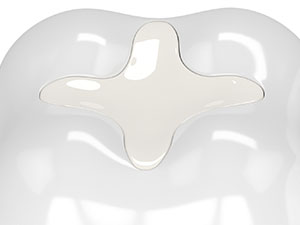
The composite systems used by dentists today integrate the highest quality of microfill particles and resin materials to produce restorations that can withstand the forces generated by all manner of oral function, while achieving attractive, natural looking and long-lasting results. Composite restorations are adhered to the underlying tooth structure through a bonding process, which also serves to seal and strengthen the tooth. Once a composite restoration is placed and is “set” or “cured”, the dentist can refine its shape as well as smooth and polish it to maximize patient comfort. This also helps to prevent the restoration from staining and to avoid premature wear. Besides providing a pleasing match to your natural tooth color, a composite restoration has other advantages over other types of restorations. Composite fillings do not require the removal of as much tooth structure to facilitate placement, nor are they subject to expansion or contraction with temperature changes as is the case with dental amalgams. However, the one drawback is that composite restorations may be more vulnerable to wear and stains over time and can require replacement down the road.
Smile Facelifts
Smile Facelifts
Restore a more youthful and vibrant appearance!
Today, you can transform your smile while enhancing facial aesthetics and jaw function! With a Dentofacial Lift from our office, you can reverse the effects of aging as well as improve the look of your smile, jawline, and overall facial profile. Best of all, there’s no need for any surgical procedures. That’s right, you won’t need a conventional, invasive facelift or jaw surgery, nor is any drilling of healthy teeth required!
This innovative approach to care combines advances in cosmetic dental restorations, jaw alignment technology, and leading-edge treatment methods to achieve optimal facial aesthetics and function.
Here’s what a Dentofacial Lift can do for you:
- Establish ideal jaw position
- Give you a younger and more vibrant appearance
- Improve your facial contours, jawline, and profile
- Enhance the look of your smile
- Correct a bad bite without drilling your teeth
- Reduce TMJ discomfort and associated symptoms
A completely non-surgical approach to care
A Dentofacial Lift from our office does not involve dermal fillers, complex orthodontic treatment, jaw surgery, or chin implants to address a less-than-perfect smile or jawline. Instead, it offers a non-invasive way improve jaw position, facial aesthetics, and TMJ function.
It takes just a few visits to look years younger
As the first step in care, we’ll carefully assess all aspects of your smile and facial aesthetics. We value patient input and pay close attention to your cosmetic goals. Every treatment plan involves optimizing jaw position to reduce the appearance of facial sagging, improve facial contours, and facilitate healthier jaw function. Once this ideal position is established, it only takes a few visits for us to design and place beautiful restorations that transform the appearance of your smile as well as support both jaw health and function.
Invisalign®
An innovative, discreet, and effective system of care, Invisalign® treatment offers a cosmetic way to align
your smile with minimal interference to daily activities using a series of clear aligners.
With aligners that are practically invisible, only you will know that you're undergoing
orthodontic care! Invisalign may, in most cases, eliminate the need for
unsightly, uncomfortable, unattractive bands and wires. Whether you are a teenager who needs
braces to correct a malocclusion or an adult who would like to straighten out
some crooked teeth, Invisalign may well be the answer for you!
Invisalign utilizes 3-D computer imaging technology to correct problematic bites or malocclusions by planning a
complete sequence of custom-made clear aligners. This series of clear aligners incrementally move the teeth into
place until the final desired corrections are reached.
With Invisalign® clear aligners, your treatment is tailored to you. Innovative technology combines
with a personalized treatment plan to make custom clear aligners for creating your new smile.
As pioneers in the field of aligner development and technology, the folks at Align Technology, Inc. gather data
from millions of treated smiles to design treatment systems that:
- Are faster, more advanced and comfortable than other options in care.
- Are able to address a broad spectrum of malocclusions ("bad bites") and teeth alignment issues.
- Allow more precise planning and control of multiple types of tooth movement.
Custom-made to the exact specifications of your smile, Invisalign clear aligners are designed to incrementally
move your teeth into their correct positions over time. Simply swap-out last week's aligner for the next one in
the series and watch as your smile progressively shows signs of improvement.
And, because Invisalign clear aligners are removable for short periods of time, as opposed to
traditional braces, you can still enjoy the foods you love as well as brush and
floss your teeth with ease!
Whether you are a teen who needs braces or an adult who yearns to "fix" their smile, Invisalign clear aligners
may be the perfect solution for you! Contact our office for more information and to schedule a consultation for
care.
Come in for a consultation
Your doctor will examine your teeth and show you what Invisalign treatment can do for you.
Get your personalized treatment plan
Start with a fast, precise digital scan. Then your doctor will map out a custom treatment plan just
for you. You will even get a preview of your smile.
Your aligners are customized for you
Your clear aligners are created using industry leading technology based on your customized treatment.
Your aligners are created with comfort in mind.
Pick up your first aligners
From the first day of treatment to the last, you're never on your own — your doctor will be with you
every step of your way.
The difference is clear
Explore the true stories and journeys of several Invisalign patients
*Invisalign is a registered trademark of Align Technology, Inc.
Frequently Asked Questions
+I want to straighten my teeth but I don't want metal
braces. What are the alternatives?
There are many options for patients who want to avoid metal braces! The most popular alternative
orthodontic treatment is Invisalign®, which are clear plastic aligners designed to straighten
teeth. After an examination of your teeth, your dentist will determine which option is best suited
to your wants and needs.
+Is Invisalign® expensive?
According to the Invisalign® website, the cost for treatment is approximately the same as the
cost for metal braces. A portion of this cost may be covered by your insurance. Please call
Lutz Dental to set up a consultation and discuss potential payment plan options.
+How does Invisalign® work?
The first step is to schedule a consultation with your doctor, so they can devise a treatment plan
that is best suited to your individual dental needs. Once approved, you will receive your first set
of aligners. Your doctor will then regularly monitor the movement of your teeth and new aligners
will be ordered according to the progress made in your treatment plan.
+What is Invisalign® made of?
Invisalign® aligners are made of clear, flexible plastic. The company received a patent for this
material – SmartTrack® – to be used exclusively for Invisalign treatment purposes. These
aligners are FDA approved and nearly invisible!
+How long does Invisalign® treatment take?
Your doctor will give you an estimate regarding how long your Invisalign® treatment should take,
which will depend on your specific needs. The average length of time for treatment is approximately
12-18 months. However, some patients may see results far sooner. Remember to wear your aligners
exactly as instructed by your doctor to obtain the best results.
+Are Invisalign® results permanent?
Your doctor will most likely recommend that you wear retainers following your Invisalign®
treatment. This is a precaution that will prevent your teeth from shifting back to their original
positioning. It is important to follow your doctor's instructions exactly to ensure long-lasting
results.
+How often must I wear my aligners?
You must wear your aligners for up to 22 hours daily. You may remove them for eating, drinking and
regular oral hygiene.
+Are there any restrictions to what I can eat while in
treatment?
No. Unlike braces, you may eat whatever you like as long as you remove the aligners before eating.
Prior to placing the aligners back on, it is important to brush your teeth and the aligners after
you eat.
+Will wearing the aligners affect my speech?
Like any orthodontic treatment, there is a short adjustment period. The more you speak with the
aligners on, the quicker you will adjust.
+Is there any discomfort with Invisalign®
treatment?
There will be some pressure and minor discomfort for a day or two after each initial insertion. This
is a sign that your teeth are moving sequentially into their final position.
+Can I chew gum?
It is recommended that you remove your aligners prior to chewing gum as the gum will stick to the
aligners.
+Can I smoke with the aligners in?
We discourage smoking with aligners as the cigarette smoke will tend to discolor them.
+How do I keep my aligners clean?
Brushing them with toothpaste will keep them fresh and clean.
+How often do I see an orthodontist while wearing
Invisalign®?
Regular office visits are every five to six weeks. This will ensure that your Invisalign treatment is
progressing as planned.
+What happens after my treatment is complete? Do I need
retainers?
All orthodontic patients are instructed to wear their retainers at night indefinitely. Sleeping with
your retainers in at night will ensure a healthy bite and maintain the new position of your teeth.
+How long does Invisalign treatment take?
Treatment time varies depending on the severity of the misaligned teeth. Treatment time can be
shorter than traditional braces, between six and 18 months.
+Does Invisalign work for kids?
Yes, if their teeth, including second molars, have grown in completely.
Veneers
Veneers

For teeth with imperfections that cannot be addressed with teeth whitening procedures, but are not so flawed as to require full coverage crowns, dental veneers can provide the desired cosmetic improvements.
Dental veneers are custom-fabricated facings that offer a conservative and cosmetically pleasing way to improve the appearance of teeth that are chipped, gapped, worn, slightly crooked, misshapen or darkly stained. With dental veneers, the color, shape, size, and length of the teeth can be changed for the better. Bonded to the front surfaces of the teeth, veneers can be used to enhance the appearance of a single tooth or multiple anterior teeth.
The two most common types of veneers are porcelain veneers, which are also known as porcelain laminates, and composite veneers. While porcelain veneers are the most commonly offered option in care, composite veneers can also achieve excellent results. Starting with a smile makeover consultation and a comprehensive assessment of a patient’s oral health as well as a discussion of the cosmetic goals, the dentist will determine a treatment plan to achieve the most pleasing outcome of care.
Porcelain Veneers
Porcelain veneers are ultra-thin facings that are custom fabricated from the highest grade of dental ceramics and offer the following benefits:
- Require very little preparation of underlying tooth structure
- Can be fabricated from start to finish in just a few visits
- Porcelain reflects light in much the same way as teeth for a naturally beautiful looking smile
- Once bonded, porcelain veneers are strong and durable and can last for many years with proper care
- Resistant to stain and discoloration
- Well tolerated by surrounding periodontal tissues
Composite Veneers
When direct composite veneers are the selected method of care, the dentist applies carefully selected shades of tooth-colored composite resins to the fronts of the involved teeth. As the composite resin is placed, it is meticulously sculpted to create the desired shape, length and overall form of each tooth. Each layer of applied composite is then cured with a special light, and additional layers of composite are placed as required to achieve an aesthetically pleasing and functional result. Once the final result is completely set, the dentist will smooth and polish the direct composite veneers to a naturally brilliant finish.
While composite veneers frequently offer the advantages of being a single visit procedure, easy to repair and an economical alternative to porcelain veneers, they are not as strong or resistant to staining and wear as dental ceramics. However, by avoiding certain dietary choices and habits, practicing good oral hygiene and getting routine dental care, direct composite veneers can offer an effective and long lasting cosmetic smile improvement.
All on 4®
Imagine a beautiful and complete smile in one day!
With the remarkable All-on-4®1 method of care, our office can help patients who either already lost or are scheduled to have all of their upper and/or lower teeth extracted quickly rebuild their smiles to speak, smile, and eat with renewed confidence and ease!
Why wait any longer to enjoy the benefits of a complete smile?
First Performed by Dr. Paulo Malo in 1998, the All-on-4 treatment concept has helped hundreds of thousands of patients reestablish attractive smiles that look, feel, and function like their very own!
It's your turn to smile again.
The All-on-4 treatment concept offers:
- A long-lasting solution for rebuilding a complete, naturally beautiful & functional smile
- Freedom from the discomfort and instability of dentures
- Four strategically placed implants to securely support a full set of upper or lower teeth
- Immediate function with an initial set of provisional teeth.
Go home with a same-day smile!
Best of all, you never have to go without teeth! With the All-on-4 method of care, a fully functional set of temporary teeth is placed the same day as your procedure. This remarkable feature offers the added benefit of having an attractive and complete smile to share with the world until healing is complete and your permanent ones get placed.
And, there's even more good news
- Fewer Implants & Shorter treatment time
- Improves Your Appearance & Your Quality of Life
- A Cost-Effective Option in Care
With a patient satisfaction rate that exceeds 95%, the All-on-4 treatment concept restores your smile and allows you to once again enjoy the foods you love!
For skilled and experienced care you can trust, contact the office of Lutz Dental. We offer the most advanced solutions to transform incomplete smiles into ones that look great, function well, and inspire confidence!
1All-on-4 is a registered trademark of Nobel Biocare
FAQs
+What is All-on-4?
The All-on-4 treatment concept offers an implant-based solution to patients who have lost all of their upper and/or lower teeth. This remarkable method of care helps patients quickly rebuild complete and beautiful smiles. With All-on-4, your new, and complete set of implant-supported replacement teeth feel secure, stable, and much like your very own.
+Is All-on-4 right for me?
If you currently wear complete upper and/or lower dentures or are slated to have your remaining teeth extracted, you may be a candidate for All-on-4. First Performed by Dr. Paulo Malo in 1998, the All-on-4 treatment concept has helped hundreds of thousands of patients quickly reestablish attractive smiles that look, feel, and function just like a set of natural teeth!
+What is the difference between All-on-4 and dentures?
The All-on-4 treatment concept offers a fixed and permanent alternative to removable dentures. Unlike dentures, All-on-4 does not rely on messy dental adhesives or natural suction to hold your new set of teeth in place. With All-on-4, your replacement teeth are permanently secured by dental implants, giving you a smile that looks not only great but also feels secure and stable. You'll feel comfortable and confident as you speak, smile, and chew with ease.
+How is All-on-4 different from other types of dental implants?
While traditional full arch implants also achieve outstanding results of care, the All-on-4 treatment concept does not involve bone grafting and requires fewer implants to support a full set of teeth. With just four strategically placed dental implants needed to support an entire set of upper or lower teeth, the All-on-4 treatment concept offers a cost-effective and satisfying solution for rebuilding a complete smile. Thanks to this remarkable method of care, patients can experience the satisfaction of having teeth placed the same day as surgery. This key feature allows patients to smile and function with confidence until healing is complete and the permanent restorations installed.
+What's the procedure for All-on-4 treatment?
Once it's been determined that you're a candidate for treatment with All-on-4, the process of treatment planning and designing your new smile begins. 3D diagnostic records provide the detailed information required to determine the exact positions of the four supporting dental implants. Then, on the day of surgery, we'll remove any remaining teeth, place the 4 implants, and insert a set of attractive, sturdy, and functional set of temporary teeth. With All-on-4, temporary teeth can be placed right away with a customized, permanent set to follow once the implants become fully integrated with the surrounding bone.
+Will I have teeth right away with All-on-4 treatment?
With All-on-4, temporary teeth can be placed right away with a customized, permanent set to follow within just a few months after the implants become fully integrated with the surrounding bone.
+Will All-on-4 give me a natural-looking smile?
Thanks to All-on-4, patients enjoy permanent teeth that look, feel, and function just like real teeth. And with a patient satisfaction rate that exceeds 95%, the All-on-4 treatment concept restores your smile, your confidence, and allows you to enjoy once again the foods you love!
+How do I take care of my new All-on-4 smile?
Maintaining your All-on-4 smile requires the same care as a natural smile. By cleaning your teeth twice daily, after meals as possible, and scheduling appointments for routine checkups as well as care, you can keep your new smile strong and healthy for years to come. Our office will demonstrate the most effective methods of oral hygiene and answer all your questions as to how to care for your new smile.
All on X
A Comprehensive Guide to Full-Arch Restoration
Tooth loss and severe dental deterioration can feel like insurmountable challenges, affecting everything from your confidence and social life to your overall health. At Lutz Dental, we believe that no one should have to settle for less than a full, functional, and beautiful smile. That's why we are proud to offer All‑On‑X—an advanced full‑arch implant solution engineered for patients who want to restore their entire upper or lower jaw efficiently, effectively, and with lasting results. In this in-depth guide, we explore how All‑On‑X works, whom it benefits, the journey from consultation to recovery, and why it has become a trusted path for life-changing transformation.
The Evolution of Full-Arch Dental Solutions
Traditional dentures have long been the go-to solution for patients who have lost most or all of their teeth. While they offer a way to restore chewing and speech, conventional dentures often come with frustrations: slips at inopportune moments, sore spots, dietary restrictions, and a feeling of unpredictability. For decades, the dental community searched for durable, long-lasting alternatives that could mimic the comfort and reliability of natural teeth.
Enter dental implants—a revolutionary step forward. With roots embedded directly into the jawbone, implants offer unparalleled stability and help preserve bone integrity. Over time, it became clear that strategically placing multiple implants could support not just individual crowns but entire arches of prosthetic teeth. First came the All‑On‑4 protocol, which employed four implants to anchor a full set of teeth. Today, we refer more broadly to All‑On‑X, where “X” denotes the number of implants—potentially four, five, six, or more—customized to the patient’s anatomy, lifestyle, and preference. This approach marries cutting-edge implant technology with artistry in prosthetic design, enabling full-arch restoration that feels and functions naturally.
Understanding the All-On-X Concept and Its Advantages
At its core, All‑On‑X is about delivering a fixed, permanent restoration for an entire arch of missing teeth using a small, efficient set of implants. Rather than removing your teeth and wearing removable dentures, All‑On‑X allows you to maintain permanent teeth that stay in place 24/7, offering substantial advantages in comfort, function, and aesthetics.
One of the most compelling benefits is stability. All‑On‑X restorations are securely anchored in the jawbone through osseointegration—the biological fusion of implant and bone—so there is no need for creams, adhesives, or concern about slipping. Chewing ability is dramatically improved, often reaching equivalence to that of natural teeth, enabling patients to enjoy a varied diet once again and absorb essential nutrients without hesitation.
Bone preservation is another critical advantage. The implants themselves stimulate the jawbone in a way that natural teeth do, inhibiting the bone loss that typically follows tooth extraction or extended denture use. Aesthetically, All‑On‑X restorations are custom-designed to match your facial structure, skin tone, and personal style, giving a balanced, natural, and lasting smile.
From a procedural standpoint, this method is efficient. Though every case is unique, most patients receive a fixed provisional arch of teeth on the same day as the implant surgery. This “teeth-in-a-day” approach reduces the number of visits, shortens healing time, and speeds up your return to normal life. For suitable patients, All‑On‑X at Lutz Dental provides a remarkably streamlined pathway to transformation.
Who Is a Good Candidate for All-On-X?
All‑On‑X is ideal for individuals facing extensive tooth loss, severe periodontal disease, or failing support structures who wish to move beyond traditional dentures. Whether teeth have been lost over time or removed due to decay or trauma, many patients find that All‑On‑X offers a permanent, life-enhancing solution.
Bones, however, tell a vital story. Adequate bone quantity and density are required to support implants. Fortunately, many patients with bone loss are still candidates thanks to the flexibility of All‑On‑X planning. Strategic placement and modern techniques such as bone grafting and ridge preservation can often prepare the jaw for successful implant placement. During the consultation, advanced three-dimensional imaging allows our team to evaluate your anatomy, rule out contraindications, and tailor a plan that ensures long-term success.
General health is another consideration. Good overall medical fitness is required to support minor surgery and the healing process. Common conditions such as controlled diabetes or hypertension generally don’t preclude treatment, whereas serious illnesses, jaw radiation, or habits like heavy smoking may require additional precautions or titrated timelines.
Psychological readiness also plays a role. While All‑On‑X brings immense benefits, it requires commitment—from post-operative care to long-term maintenance. Patients who understand the process, have realistic expectations, and are willing to participate in their own care tend to enjoy the best outcomes.
Planning and Personalized Workflow at Lutz Dental
Every All‑On‑X journey at Lutz Dental begins with a comprehensive consultation. We take a detailed history of your dental issues, assess your aesthetic desires, and document your oral and medical health. Advanced imaging, often including a cone‑beam CT scan, allows us to view the jawbone in precise detail. This data feeds into guided surgical planning, securing optimal implant placement that accommodates anatomy, bite alignment, and esthetic balance.
From there, we design a personalized restorative plan. This includes selecting the best material—often hybrid prosthetics combining titanium or zirconia frameworks with natural-looking crowns—while ensuring correct color, shape, and bite. You’ll receive a provisional arch of teeth immediately after surgery in most cases, allowing you to leave with a functional, confident smile immediately.
Over the ensuing months, your jawbone heals and integrates with the implants. Once we confirm stability, typically at the 3‑ or 4‑month mark, the provisional is replaced with a durable final prosthesis. This transitional phase allows us to adjust fit, comfort, and appearance, ensuring your final outcome is perfect and customized to your needs.
The Surgical Procedure: Precision, Comfort, and Care
With planning finalized, surgical placement begins. Conducted under comfortable sedation or local anesthesia, you remain pain-free while our expert team positions each implant via minimal incisions. Guided surgical stents ensure pinpoint accuracy, allowing for a stable foundation provided by the implants.
For convenience, the prosthetic arch is typically attached on the same day—giving you an immediate smile that is fully functional, though with some dietary considerations until healing progresses. Our team provides thorough post-operative guidance so you can manage discomfort, swelling, and oral hygiene safely at home.
Over the next few months, the implants integrate with your bone, affording a secure anchor for your permanent prosthesis. Once osseointegration is confirmed through clinical tests and imaging, we move forward with crafting and delivering your final All‑On‑X prosthesis—a testament to your new, lasting smile.
Recovery and Long-Term Maintenance
After the procedure, most patients feel little more than slight soreness comparable to that experienced after a tooth extraction. Mild discomfort, swelling, or bruising may occur, but these typically resolve within days. Despite limitations on hard foods during the healing phase, most patients return to work and everyday activities within a few days to a week.
All‑On‑X is designed for permanence, but longevity depends on maintenance. Daily cleaning under and around the prosthesis, periodic professional cleanings, and routine exams are crucial. With care, many patients enjoy their All‑On‑X restorations for decades. Implants don’t decay like natural teeth, though healthy gum tissue around them is still essential to ward off peri-implant disease. At Lutz Dental, we provide education and tools to help you maintain your restoration, detect early issues, and preserve your investment.
Advantages Over Alternative Full-Arch Options
Compared to removable dentures, All‑On‑X stands alone in comfort, function, and longevity. A fixed restoration gives you the confidence to talk, laugh, and eat without hesitation or fear of slippage. Meanwhile, bone preservation is unmatched—traditional dentures and tooth loss accelerate bone loss, but implants actively maintain the jaw's integrity.
Full-arch bridges supported by natural teeth are known to burden adjacent teeth and risk structural weakening over time. All‑On‑X avoids this by using implants as anchors, preserving natural teeth when present, and reducing stress on existing structures.
While individual implants and bridges are viable solutions for multiple missing teeth, they can be impractical when extensive tooth loss spans an entire arch. All‑On‑X provides a streamlined, durable alternative that matches or exceeds the performance of individual restorations—with fewer parts to trouble.
Addressing Common Concerns
Many patients ask whether All‑On‑X feels like “real” teeth. The answer is a resounding yes. From the moment the provisional prosthesis is placed, patients report sensations that more closely resemble natural dentition than traditional dentures. Speech returns quickly, and chewing efficiency is significant.
Another frequent concern surrounds cost. While initial investment for All‑On‑X is higher than dentures, it offers long-term value through reduced need for replacements, adhesives, and extensive follow-up dentistry. Many patients view it as an investment for lifelong function and confidence.
Finally, there's the worry about surgical pain. Most patients describe the experience as no more painful than tooth extraction, thanks to modern anesthetic techniques and careful surgical methods. Post-operative discomfort is minimal and well-managed with typical pain medications.
Real Patient Stories: Life Transformed
At Lutz Dental, we’ve witnessed incredible transformations. One patient, once embarrassed by a failing smile and unable to enjoy favorite foods, now gleams at every photo and delights in their restored ability to eat steak, raw fruits, and chewy bread. Another patient, who had avoided social situations due to slipping dentures, now laughs freely and expresses gratitude for the freedom All‑On‑X restored to their daily life.
These are more than aesthetic victories—they are emotional and social breakthroughs. Full-arch restoration with All‑On‑X rekindles confidence, revitalizes health, and reconnects patients with the small joys of everyday living.
All-On-X and the Lutz, FL Community: Personalized Smile Restoration Close to Home
Lutz, Florida, is more than just a dot on the map—it’s a tight-knit community of families, retirees, professionals, and long-time residents who value comfort, quality, and connection. At Lutz Dental, we’re proud to serve this vibrant town by offering advanced solutions like All-On-X to those looking for dependable, life-enhancing dental care right here at home. Whether you're a lifelong resident or newly settling into the area’s peaceful neighborhoods, the opportunity to restore your smile with world-class technology is just minutes away.
Lutz is a place where people value relationships, local businesses, and personal attention. That same spirit guides our approach to All-On-X treatment. We know that making a decision about full-arch dental restoration is deeply personal, and we treat it as such. Our team takes the time to listen to your story, understand your concerns, and customize your care with the compassion and attention that mirrors the values of the Lutz community.
Many of our All-On-X patients come from right here in Lutz—individuals who want to stop traveling to Tampa or other cities for advanced care. With our local expertise and comprehensive services, there's no need to leave town to get high-end dental restoration. Whether you’re visiting us from Crystal Lake, Cheval, or the golf courses of Heritage Harbor, you’ll find a comfortable, familiar setting and a team that treats you like family.
By providing All-On-X in Lutz, we’re not just restoring teeth—we’re restoring confidence, functionality, and quality of life for the people who make this community special. At Lutz Dental, we believe your best smile shouldn’t come from a distant specialist—it should come from a neighbor you trust, right here in Lutz.
Why Choose Lutz Dental for Your All-On-X Journey
Choosing a dental provider for such a life-changing procedure is a decision you don’t take lightly. At Lutz Dental, we bring together experienced implant surgeons, restorative experts, and compassionate staff to offer a care experience rooted in precision and kindness.
We prioritize comprehensive diagnostics, advanced technology, and personalized treatment plans designed for your anatomy and goals. Our commitment to excellence is present in every stage—from digital smile design and surgical accuracy to high-quality materials and proactive follow-up.
Above all, we value the trust our patients place in us. We listen to concerns, answer every question, and ensure you feel supported from consultation through long-term maintenance. For us, All‑On‑X is not just about replacing teeth—it’s about restoring smiles, dignity, and life.
All‑On‑X represents a paradigm shift in full-arch tooth replacement. By combining cutting-edge implant technology, meticulous planning, and immediate provisional solutions, it offers a pathway to permanent, natural-feeling, fully functional teeth. When executed by a dedicated team using advanced materials—like the experts at Lutz Dental—All‑On‑X can restore not just smiles, but quality of life.
If you or someone you care about is facing extensive tooth loss or denture fatigue, exploring All‑On‑X could be the most liberating decision you make. Let Lutz Dental guide you through every step: evaluation, planning, implantation, and long-term care—with the goal of helping you rediscover chewing with confidence, laughing without reservation, and living fully again.
FAQs
+What is All-On-X and how is it different from traditional dentures?
All-On-X is a full-arch dental implant solution that replaces an entire set of upper or lower teeth using as few as four strategically placed implants. Unlike traditional dentures, which rest on the gums and are removable, All-On-X restorations are fixed in place and anchored directly to the jawbone. This provides significantly greater stability, chewing power, and comfort—no slipping, no adhesives, and no taking them out at night.
+How long does the All-On-X procedure take from start to finish?
The entire process varies depending on your individual case, but many patients receive a provisional (temporary) arch of teeth on the same day as their implant surgery. After a healing period of around three to six months, once the implants have fused with the bone, a custom-crafted final prosthesis is placed. From consultation to completion, most treatments are completed in four to six months, with functional results starting almost immediately.
+Am I a candidate for All-On-X if I’ve had bone loss?
Yes, you may still be a candidate. One of the key advantages of All-On-X is its flexibility in implant placement, which often allows us to avoid areas with significant bone loss. If needed, bone grafting or sinus lifts can be performed to create a more stable foundation. Our team at Lutz Dental uses advanced 3D imaging to evaluate your bone health and customize the best approach for your case.
+Does the All-On-X procedure hurt?
The surgery itself is not painful, as it is performed under local anesthesia and often with sedation to ensure complete comfort. After the procedure, some soreness or swelling is normal and typically managed with over-the-counter pain relievers or mild prescription medications. Most patients say the recovery is far easier than expected, and the results make any short-term discomfort more than worth it.
+How long will my All-On-X implants last?
With proper care, All-On-X implants can last 20 years or more. The implants themselves are designed to be permanent, while the prosthetic arch may eventually require maintenance or replacement after 10–15 years due to normal wear. Regular dental visits, good oral hygiene, and avoiding habits like smoking help maximize the longevity of your restoration.
+Will my new teeth look natural?
Absolutely. One of the hallmarks of All-On-X is its ability to deliver a highly aesthetic, natural-looking result. At Lutz Dental, we customize the shape, color, and contour of your prosthetic teeth to match your facial features, age, and preferences. The result is a smile that looks—and feels—like your own.
+Is All-On-X available here in Lutz, or do I need to travel?
You don’t need to go anywhere else. Lutz Dental proudly offers All-On-X treatment right here in town, making it easy and convenient for you to receive advanced full-arch restoration close to home. From consultation and imaging to surgery and final delivery, every step is handled by our experienced team in a comfortable, trusted local setting.
Smile Makeover
Smile Makeover
![service image]()
A beautiful smile not only radiates personal warmth, but it also illuminates your face and accentuates your best features. Ideally, when you smile your teeth and only a minimal amount of gum tissue should be evident. However, a “gummy” smile displays an excess amount of pink gingiva, diminishing one’s facial aesthetics and even compromising the look of a well-aligned and vibrant smile.
Whether a gummy smile is the result of a jaw growth discrepancy, the overgrowth of gingival tissue, a high lip line, a larger than normal muscle attachment, or teeth that are too small, there are several options in care to transform and improve the look of a less-than-perfect smile.
At our office, we analyze every aspect of your smile, including how much tooth structure vs. the amount of gum tissue that is showing when you smile. We’ll then recommend the best course of care to improve the appearance of your smile. While some cases can be treated with procedures such as the cosmetic re-contouring of the gums, or a laser frenectomy, other cases may require orthodontic care or a consultation with an oral surgeon. Whatever the case may be, you can rest assured that the look, health, and function of your smile is in the best of hands at our office.
Sedation Dentistry
Gentle Sedation Dentistry
Feel calm, comfortable, and cared for at Lutz Dental
At Lutz Dental, your comfort during treatment is our top priority. Whether you're feeling anxious, sensitive, or just prefer a quieter experience, our sedation options help you relax so you can get the dental care you deserve.
Who benefits from sedation dentistry?
It’s our mission to make dental visits stress-free. Sedation may be ideal if you:
- Feel anxious or fearful about dental work
- Have had unpleasant past dental experiences
- Need extensive procedures in a single visit
- Have a sensitive gag reflex or reactive teeth
- Prefer a calm, relaxed atmosphere
Available sedation options at Lutz Dental
Local Anesthetic (No Sedation)
We begin with a topical gel before gently numbing the area—often enhanced by vibration tools to reduce injection discomfort.
Nitrous Oxide (“Laughing Gas”)
Ideal for mild anxiety, this safe inhalation sedative helps you stay calm and alert. Effects fade quickly after treatment.
Oral Sedation
Take one or two prescribed pills before your procedure. This option delivers moderate sedation—many patients drift off and have little or no memory of the visit. A driver is required.
Intravenous (IV) Sedation
For deeper relaxation, IV sedation acts quickly and is easily adjustable. You’ll stay conscious and breathing on your own, often with minimal or no memory of the procedure. A driver is mandatory.
Why choose sedation at Lutz Dental?
- Comfort comes first – sedation dampens anxiety and unwanted sounds, tastes, or smells.
- Efficient care – handle multiple treatments in one visit.
- Safety-focused – licensed dentists use advanced monitoring throughout the service.
- Little to no recollection – most patients don't remember the procedure.
Common concerns we address
- Needles, drills, sounds? No worries—sedation neutralizes those stressors.
- Sensitive gag reflex? We’ve got you covered.
- Long procedures? Sedation makes them easy to power through.
What to expect with IV sedation
- Fast-acting delivery through a small IV line
- Ongoing monitoring of vital signs and oxygen
- You remain responsive yet deeply relaxed
- Minimal memory of the appointment afterward
- You’ll need a ride home and rest for the remainder of the day
Ready to experience relaxed dentistry?
Let’s find the right sedation plan for you. Whether you need help with routine cleanings, restorative treatments, or complex procedures—our caring team at Lutz Dental is ready to personalize your experience. We’re here to help remove fear and put your smile first.
Call today or book online to discuss which sedation option fits your needs.


























